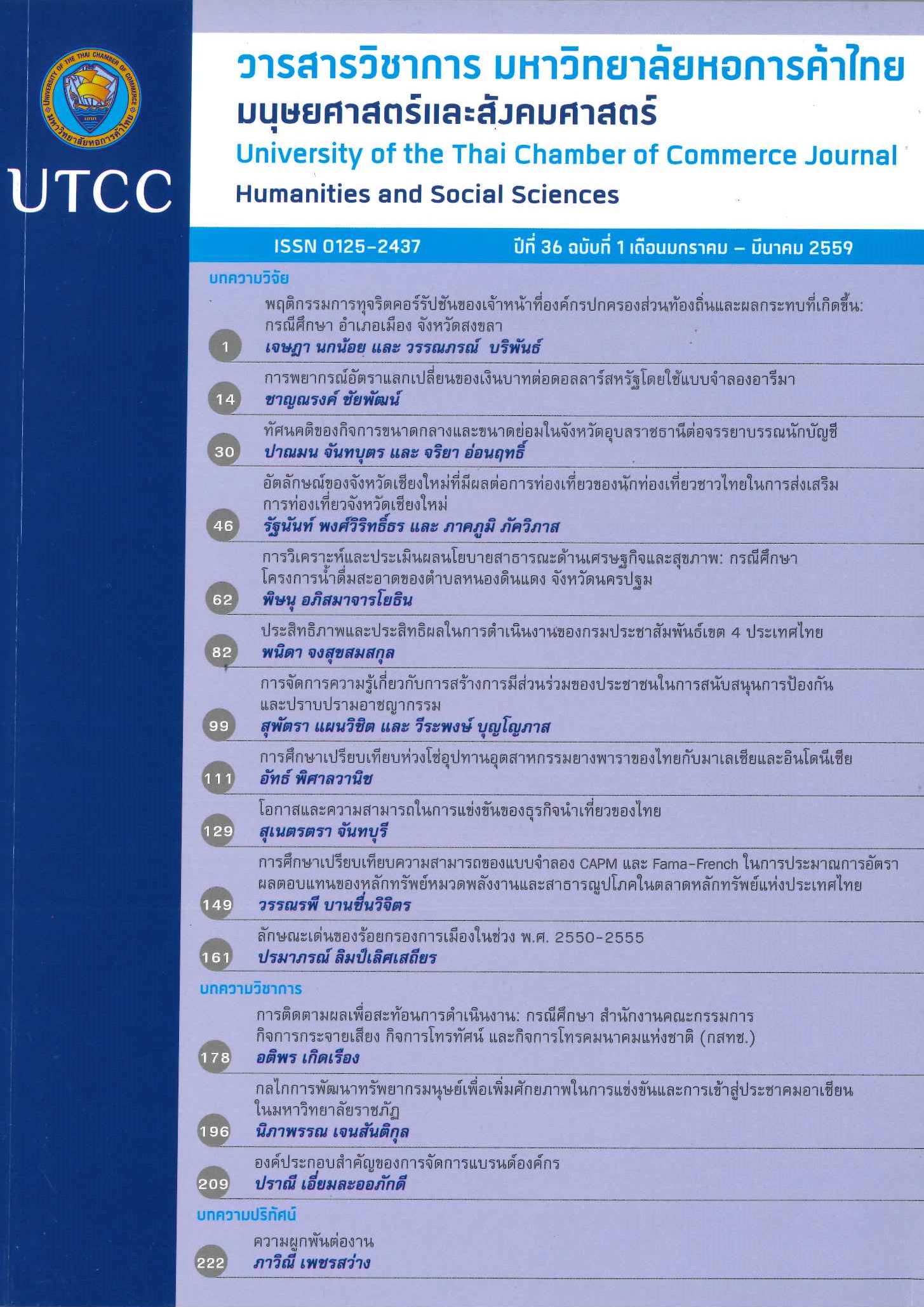Forecasting Thai Baht vs U.S. Dollar Rates Using the ARIMA Model
Main Article Content
Abstract
Since Thailand adjusted to implement a floating exchange rate regime, the exchange rate of the Thai baht against the U.S. dollar has been changing all the time. This has affected loss or gain profits for international business transactions as a result of foreign exchange rate fluctuations. This study aims to create a model to estimate and forecast the exchange rate of the Thai baht against the U.S. dollar based on analysis of the time series using the ARIMA model and a data collection from )anuary 2011 to November 2014. The findings reveal that during the study period the THB/USD exchange rate fell between THB 29-33 / USD. The findings also indicate that the appropriate ARIMA model for forecasting the exchange rate of THB/USD is (1, 0, 0) (1, 1, 0). When using this model to predict the exchange rate of THB/USD in the second half of the year 2015, it turns out that the exchange rate tends to be stronger, reaching THB 33-34 / USD. This currency movement is consistent with the fact that the U.S. economy is slowly recovering. Therefore, business transactions dealing with USD should be done with extreme care. Traders, especially importers, are recommended to have risk assessment and preventive measures because the U.S. currency is likely to become stronger.
Article Details
ลิขสิทธิ์ของบทความ
ผลงานที่ได้รับการตีพิมพ์ถือเป็นลิขสิทธิ์ของมหาวิทยาลัยหอการค้าไทย ห้ามมิให้นำเนื้อหา ทัศนะ หรือข้อคิดเห็นใด ๆ ของผลงานไปทำซ้ำ ดัดแปลง หรือเผยแพร่ ไม่ว่าทั้งหมดหรือบางส่วนโดยไม่ได้รับอนุญาตเป็นลายลักษณ์อักษรจากมหาวิทยาลัยหอการค้าไทยก่อน
References
Bank of Thailand. 2015. Foreign Exchange Rate [Online]. Available: https://www2.bot.or.th/ statistics/B.TWEBSTATaspx?reportID=123&language=TH (in Thai).
ธนาคารแห่งประเทศไทย. 2556. อัตราแลกเปลี่ยนเงินตราต่างประเทศ [ ออนไลน์ ]. เข้าถึงจาก: https://www2.bot.or.th/statistics/B.TWEBSTATaspx?reportID=123 & language=TH
Box, G.E.P., Jenkins, G.M., and Reinsel, G.C.1994. Time Series Analysis Forecasting and Control.3rd. ed. Englewood Cliffs, NJ:Prentice-Hall.
Hatchavanich, D. 2013. “A Comparison of Forecasting Models for the Monthly Consumer price Index: Box-Jenkins and Exponential Smoothing Models.”University of the Thai Chamber of Commerce Journal33,2:100-113. (in Thai).
ดวงพร หัชชะวณิช.2556."การเปรียบเทียบตัวแบบการพยากรณ์ดัชนีราคาผู้บริโภครายเดือน:ตัวแบบบอกซ์-เจนกินส์ และตัวแบบปรับให้เรียบเอกซ์โพเนนเซียล." วารสารวิชาการมหาวิทยาลัยหอการค้าไทย 33,2: 100 - 113.
Jansod. A. 2007. “Accuracy Comparison in Foreign Exchange Rate Forecasting Between Neural Networks and ARIMA GARCH-M Models.” Master’s Thesis,Department of Economics, Chiang Mai University. (in Thai).
อดิเรก จันทร์สด .2550. "การเปรียบเทียบความแม่นยำในการพยากรณ์อัตราแลกเปลี่ยนเงินตราต่างประเทศระหว่างแบบจำลองนิวรอลเน็ตเวิร์ค แบบจำลองอารีมา แบบจำลองการ์ซเอ็ม." วิทยานิพนธ์ปริญญามหาบัณฑิต สาขาเศรษฐศาสตร์ มหาวิทยาลัยเชียงใหม่.
Mammadova, G.2010. Forecasting Exchange Rates Using ARMA and Neural Network Model. Master’s Thesis, Department of Economics, Western Illinois University.
Rattanapongpinyo. T.2010. “A Study of Factors Affecting the Short-term Movement of the Thai Baht vs the US Dollar.” University of the Thai Chamber of Commerce Journal 30,1: 1-10. (in Thai).
ธนินทร์รัฐ รัตนพงศ์ภิญโญ. 2553. "การศึกษาปัจจัยที่มีผลกระทบต่อการเคลื่อนไหวระยะสั้นของค่าเงินบาทต่อดอลลาร์สหรัฐอเมริกา."วารสารวิชาการ มหาวิทยาลัยหอการค้าไทย 30,1: 1-10.
Rout, M., et al.2014. “Forecasting of Currency Exchange Rates Using and Adaptive ARMA Model with Differential Evolution Based Training.”Journal of King Saud University - Computer and Information Sciences 26, 1: 7-18.
Saothayanun, L., et al. 2012. “A Comparison of the Forecasts for Rubber /rices Using ARIMA and GARCH Models.”University of the Thai Chamber of Commerce Journal 32, 3: 115-128.(in Thai).
ลักขณา เศาธยะนันท์, และคณะ.2555. "การเปรียบเทียบค่าพยากรณ์ราคายางพาราด้วยตัวแบบ ARIMA และตัวแบบ GARCH." วารสารวิชาการ มหาวิทยาลัยหอการค้าไทย 32,3: 115-128.
Sinchaikit, S. 2011. “Modeling of Exchange Rate and Gold Price Volatilities of Thailand Using Bivariate GARCH.” Master’s Thesis, Department of Economics, Chiang Mai University. (in Thai).
สันติพงษ์ สินชัยกิจ. 2554. "การจำลองแบบความผันผวนของอัตราแลกเปลี่ยนโดยวิธีไบวาร์ริเอทการ์ช." วิทยานิพนธ์ปริญยามหาบัณฑิต สาขาเศรษฐศาสตร์ มหาวิทยาลัยเชียงใหม่.


